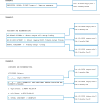Automated annotation and classification of BI-RADS assessment from radiology reports
- PMID: 28428140
- PMCID: PMC5706448
- DOI: 10.1016/j.jbi.2017.04.011
Automated annotation and classification of BI-RADS assessment from radiology reports
Abstract
The Breast Imaging Reporting and Data System (BI-RADS) was developed to reduce variation in the descriptions of findings. Manual analysis of breast radiology report data is challenging but is necessary for clinical and healthcare quality assurance activities. The objective of this study is to develop a natural language processing (NLP) system for automated BI-RADS categories extraction from breast radiology reports. We evaluated an existing rule-based NLP algorithm, and then we developed and evaluated our own method using a supervised machine learning approach. We divided the BI-RADS category extraction task into two specific tasks: (1) annotation of all BI-RADS category values within a report, (2) classification of the laterality of each BI-RADS category value. We used one algorithm for task 1 and evaluated three algorithms for task 2. Across all evaluations and model training, we used a total of 2159 radiology reports from 18 hospitals, from 2003 to 2015. Performance with the existing rule-based algorithm was not satisfactory. Conditional random fields showed a high performance for task 1 with an F-1 measure of 0.95. Rules from partial decision trees (PART) algorithm showed the best performance across classes for task 2 with a weighted F-1 measure of 0.91 for BIRADS 0-6, and 0.93 for BIRADS 3-5. Classification performance by class showed that performance improved for all classes from Naïve Bayes to Support Vector Machine (SVM), and also from SVM to PART. Our system is able to annotate and classify all BI-RADS mentions present in a single radiology report and can serve as the foundation for future studies that will leverage automated BI-RADS annotation, to provide feedback to radiologists as part of a learning health system loop.
Keywords: Breast Imaging Reporting and Data System (BI-RADS); Imaging informatics; Information extraction; Machine learning; Natural language processing.
Copyright © 2017. Published by Elsevier Inc.
Conflict of interest statement
At the time of this publication, the authors do not report any conflict of interest.
Figures
Similar articles
-
TECRR: a benchmark dataset of radiological reports for BI-RADS classification with machine learning, deep learning, and large language model baselines.BMC Med Inform Decis Mak. 2024 Oct 24;24(1):310. doi: 10.1186/s12911-024-02717-7. BMC Med Inform Decis Mak. 2024. PMID: 39444035 Free PMC article.
-
Using automatically extracted information from mammography reports for decision-support.J Biomed Inform. 2016 Aug;62:224-31. doi: 10.1016/j.jbi.2016.07.001. Epub 2016 Jul 4. J Biomed Inform. 2016. PMID: 27388877 Free PMC article.
-
Extraction of BI-RADS findings from breast ultrasound reports in Chinese using deep learning approaches.Int J Med Inform. 2018 Nov;119:17-21. doi: 10.1016/j.ijmedinf.2018.08.009. Epub 2018 Aug 18. Int J Med Inform. 2018. PMID: 30342682
-
Current Status and Future of BI-RADS in Multimodality Imaging, From the AJR Special Series on Radiology Reporting and Data Systems.AJR Am J Roentgenol. 2021 Apr;216(4):860-873. doi: 10.2214/AJR.20.24894. Epub 2021 Feb 24. AJR Am J Roentgenol. 2021. PMID: 33295802 Review.
-
BI-RADS® fifth edition: A summary of changes.Diagn Interv Imaging. 2017 Mar;98(3):179-190. doi: 10.1016/j.diii.2017.01.001. Epub 2017 Jan 25. Diagn Interv Imaging. 2017. PMID: 28131457 Review.
Cited by
-
Automatic inference of BI-RADS final assessment categories from narrative mammography report findings.J Biomed Inform. 2019 Apr;92:103137. doi: 10.1016/j.jbi.2019.103137. Epub 2019 Feb 23. J Biomed Inform. 2019. PMID: 30807833 Free PMC article.
-
Natural Language Processing of Clinical Notes on Chronic Diseases: Systematic Review.JMIR Med Inform. 2019 Apr 27;7(2):e12239. doi: 10.2196/12239. JMIR Med Inform. 2019. PMID: 31066697 Free PMC article. Review.
-
Natural Language Processing to Ascertain Cancer Outcomes From Medical Oncologist Notes.JCO Clin Cancer Inform. 2020 Aug;4:680-690. doi: 10.1200/CCI.20.00020. JCO Clin Cancer Inform. 2020. PMID: 32755459 Free PMC article.
-
Natural Language Processing for EHR-Based Computational Phenotyping.IEEE/ACM Trans Comput Biol Bioinform. 2019 Jan-Feb;16(1):139-153. doi: 10.1109/TCBB.2018.2849968. Epub 2018 Jun 25. IEEE/ACM Trans Comput Biol Bioinform. 2019. PMID: 29994486 Free PMC article. Review.
-
Clinical concept extraction: A methodology review.J Biomed Inform. 2020 Sep;109:103526. doi: 10.1016/j.jbi.2020.103526. Epub 2020 Aug 6. J Biomed Inform. 2020. PMID: 32768446 Free PMC article. Review.
References
-
- Siegel RL, Miller KD, Jemal A. Cancer statistics, 2016: Cancer Statistics, 2016. CA Cancer J Clin. 2016;66:7–30. - PubMed
-
- Torre LA, Bray F, Siegel RL, Ferlay J, Lortet-Tieulent J, Jemal A. Global cancer statistics, 2012: Global Cancer Statistics, 2012. CA Cancer J Clin. 2015;65:87–108. - PubMed
-
- Berry DA, Cronin KA, Plevritis SK, Fryback DG, Clarke L, Zelen M, et al. Effect of Screening and Adjuvant Therapy on Mortality from Breast Cancer. New England Journal of Medicine. 2005;353:1784–92. - PubMed
-
- U.S. Preventive Services Task Force. Screening for breast cancer: U.S. Preventive Services Task Force recommendation statement. Ann Intern Med. 2009;151:716–26. W-236. - PubMed
MeSH terms
Grants and funding
LinkOut - more resources
Full Text Sources
Other Literature Sources
Medical




